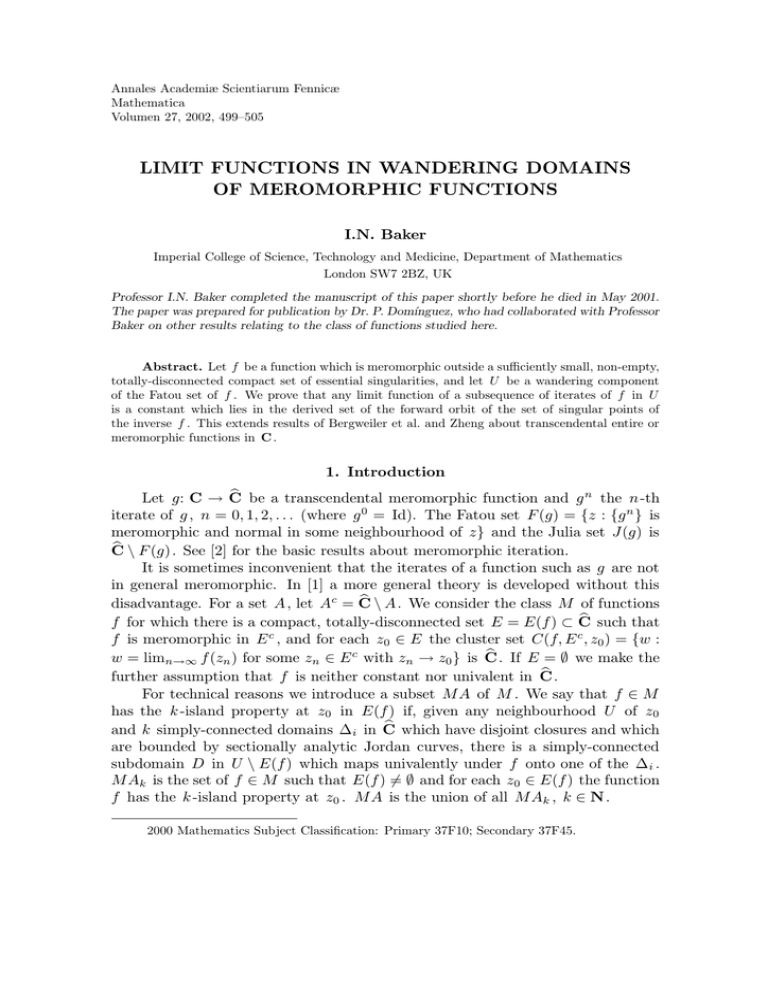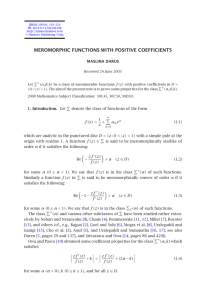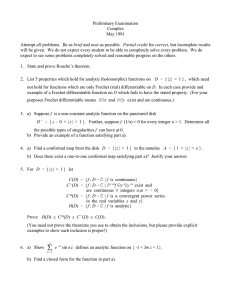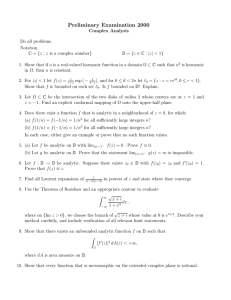LIMIT FUNCTIONS IN WANDERING DOMAINS OF MEROMORPHIC FUNCTIONS I.N. Baker
advertisement

Annales Academiæ Scientiarum Fennicæ
Mathematica
Volumen 27, 2002, 499–505
LIMIT FUNCTIONS IN WANDERING DOMAINS
OF MEROMORPHIC FUNCTIONS
I.N. Baker
Imperial College of Science, Technology and Medicine, Department of Mathematics
London SW7 2BZ, UK
Professor I.N. Baker completed the manuscript of this paper shortly before he died in May 2001.
The paper was prepared for publication by Dr. P. Domı́nguez, who had collaborated with Professor
Baker on other results relating to the class of functions studied here.
Abstract. Let f be a function which is meromorphic outside a sufficiently small, non-empty,
totally-disconnected compact set of essential singularities, and let U be a wandering component
of the Fatou set of f . We prove that any limit function of a subsequence of iterates of f in U
is a constant which lies in the derived set of the forward orbit of the set of singular points of
the inverse f . This extends results of Bergweiler et al. and Zheng about transcendental entire or
meromorphic functions in C .
1. Introduction
b be a transcendental meromorphic function and g n the n -th
Let g: C → C
iterate of g , n = 0, 1, 2, . . . (where g 0 = Id). The Fatou set F (g) = {z : {g n } is
meromorphic and normal in some neighbourhood of z} and the Julia set J(g) is
b \ F (g) . See [2] for the basic results about meromorphic iteration.
C
It is sometimes inconvenient that the iterates of a function such as g are not
in general meromorphic. In [1] a more general theory is developed without this
b \ A . We consider the class M of functions
disadvantage. For a set A , let Ac = C
b such that
f for which there is a compact, totally-disconnected set E = E(f ) ⊂ C
c
c
f is meromorphic in E , and for each z0 ∈ E the cluster set C(f, E , z0 ) = {w :
b . If E = ∅ we make the
w = limn→∞ f (zn ) for some zn ∈ E c with zn → z0 } is C
b.
further assumption that f is neither constant nor univalent in C
For technical reasons we introduce a subset M A of M . We say that f ∈ M
has the k -island property at z0 in E(f ) if, given any neighbourhood U of z0
b which have disjoint closures and which
and k simply-connected domains ∆i in C
are bounded by sectionally analytic Jordan curves, there is a simply-connected
subdomain D in U \ E(f ) which maps univalently under f onto one of the ∆ i .
M Ak is the set of f ∈ M such that E(f ) 6= ∅ and for each z0 ∈ E(f ) the function
f has the k -island property at z0 . M A is the union of all M Ak , k ∈ N .
2000 Mathematics Subject Classification: Primary 37F10; Secondary 37F45.
500
I.N. Baker
A simpler but smaller class of functions introduced by A. Bolsch [4] is K =
{f ∈ M : E(f ) is compact and countable} . We have K ⊂ M Ak ⊂ M , and all
three classes are closed under composition of functions. Thus K includes any
function of the type f1 ◦ f2 ◦ · · · ◦ fn , where fi are meromorphic in C .
It is shown in [1] that applying the definitions given above for F (g) , J(g)
to functions f in M yields a completely invariant F (f ) and a perfect set J(f ) .
Moreover f ∈ M implies that f m ∈ M and F (f m ) = F (f ) . If, in addition,
f ∈ M A , then repelling cycles are dense in J(f ) .
If U is a component of F (f ) , f ∈ M , then for each k ∈ N , f k (U ) is contained
in some component Uk of F (f ) . If the sequence Uk is eventually periodic we have
only to understand the behaviour of iterates in some periodic component, indeed
by replacing f by an iterate we could study only invariant components. Here only
a few cases arise and are reasonably well understood (see below). The other case
is when all Uk are different and U is said to be a wandering component. In such
a component any convergent sequence of iterates has a limit function which is a
constant in J(f ) (see [1]).
The possible constant limits are connected with the singular values of the
inverse f −1 . If f ∈ M , the set S(f ) of singular values of some branch of f −1
consists of the critical values f (c) , where f 0 (c) = 0 , together with the set of all
asymptotic values of f : w is an asymptotic value of f if there is some¡ z 0 ∈
¢ E(f )
and a path γ(t) , 0 ≤ t < 1 , in E(f )c such that γ(t) → z0 and f γ(t) → w
¡
¢
Sj−1
as t → 1 . Further, Ej (f ) = k=0 f −k E(f ) is the set of essential singularities
of f j , and the set where for some n ∈ N some branch of f −n has a singularity is
P (f ) =
∞
S
j=0
¡
¢
f j S(f ) \ Ej (f ) ,
where E0 (f ) = ∅.
Thus P (f ) consists of the forward orbit of S(f ) , so far as this is defined. For a
set A , the derived set of A is denoted by A0 .
Theorem 1. If f ∈ M A and U is a wandering component of F (f ) , then
any limit function of a sequence of iterates in U is a constant which lies in P (f ) 0 .
Remarks. M A includes K and in particular any (non-constant, non-univalent) function meromorphic in C . Rational functions have no wandering components but transcendental ones may do so. The result was proved for transcendental
entire functions by Bergweiler et al. [3]. Zheng [9] extended it to transcendental
meromorphic functions but with an additional hypothesis. In [10] he has removed
this restriction.
The theorem can be used to prove the non-existence of wandering domains
given suitable information about S(f ) and its forward orbit.
Recall that a fixed point a of f satisfies f (a) = a . If a is finite the multiplier
is λ(a) = f 0 (a) . If a is ∞ we define the multiplier by conjugating f so that a
Limit functions in wandering domains of meromorphic functions
501
becomes finite. The fixed point is attracting if |λ(a)| < 1 and parabolic if λ(a)
is a primitive p -th root of unity for some p ∈ N . Concerning the behaviour of
iterates in a non-wandering component it is enough to know the following.
If f ∈ M and U is a component of F (f ) such that f (U ) ⊂ U , then precisely
one of the following is true; see [1].
(i) U contains an attracting fixed point a . For z ∈ U we have f n (z) → a as
n → ∞ . U is called the immediate attractive basin of a .
(ii) U is a domain of attraction of a parabolic fixed point a ∈ ∂U and for z ∈ U
we have f n (z) → a as n → ∞ .
(iii) There is an ¡analytic
homeomorphism
ψ: U → D , where D is the unit disc,
¡
¢¢
such that ψ f ψ −1 (z) = e2πiα z , for some α ∈ R \ Q . In this case U is
called a Siegel disc.
(iv) There is an analytic homeomorphism
¡ ¡ ψ: U¢¢→ A where A is an annulus
A = {z : 1 < |z| < r} such that ψ f ψ −1 (z) = e2πiα z for some α ∈ R \ Q .
In this case U is called a Herman ring.
(v) There exists a ∈ ∂U such that f n (z) → a , for z ∈ U as n → ∞ , but
f is not meromorphic at a . There exists a path γ ⊂ U leading to a such
that f (γ) ⊂ γ and the spherical distance between f (z) and z tends to zero as
z → a on γ . In this case U is called essentially parabolic at a or alternatively
a ‘Baker domain’.
We may note that if a is a parabolic fixed point whose multiplier is a primitive
p -th root of unity, then it has multiplier 1 as a fixed point of f p . In fact there
are then kp domains Ui of F (f ) (for some k ∈ N ), each invariant under f p , in
which f n → a . We can now state the following.
Theorem 2. If f ∈ M A and U is a component of F (f ) such that f n → a
b , then either (i) a is an attracting fixed point of f , (ii) a is a
in U , where a ∈ C
parabolic fixed point of f , or (iii) a ∈ E(f ) ∩ S(f )0 .
Thus the only cases where f is meromorphic at a are (i) and (ii) which correspond to the first two non-wandering cases described above. In (iii) U is either
a wandering domain or a Baker domain. The idea of the proof goes back to Eremenko and Lyubich [5] who deal with the case where f is transcendental entire
and S(f ) is bounded ( E(f ) = {∞} ). Their work was taken up in the meromorphic case by Bergweiler [2], Rippon and Stallard [8] and Zheng [10], who proved
Theorem 2 for functions meromorphic in C (by a somewhat different method).
So far as Theorem 2 relates to the case of a Baker domain it is proved in [1,
Theorem F].
An advantage of working in the class M A or K is that we can apply our
results automatically to f p without special discussion of periodic cycles etc. Also
we have no need to separate finite and infinite limits.
There are of course many examples in which case (iii) of Theorem 2 applies,
for example entire functions with wandering components in which f n → ∞ .
502
I.N. Baker
2. Proof of Theorem 1
Suppose that f ∈ M A has a wandering component U of F (f ) such that
for some integers nk increasing to ∞ the sequence f nk → a in U , where a is a
constant which we may assume to be 0 (for f may be conjugated by a Möbius
transform). Recall that 0 ∈ J(f ) . We assume that there is a positive ε such that
the set N = D(0, ε) \ {0} does not meet P (f ) and shall derive a contradiction.
I. Since periodic cycles are dense in J(f ) it follows that f has some cycle
{α1 , . . . , αj } of length j ≥ 3 such that no αi = 0 . The constant ε will be chosen
so that all αi are outside N . For a disc D = D(z0 , r) with D ⊂ U we have
Dk = f nk (D) ⊂ N for all sufficiently large k . We may replace U by a suitable
f j (U ) and adjust the notation to get Dk ⊂ N for all k and D ⊂ N . We have
wk = f nk (z0 ) → 0 as k → ∞ .
Let gk be the branch of f −nk such that gk (wk ) = z0 . Fix a value of uk =
log(wk ) , noting that wk 6= 0 since wk ∈ F (f ) . Then hk (t) = gk (exp t) is analytic
near t = uk , hk (uk ) = z0 , and hk continues throughout H = {t : Re t < log ε}
to give a single-valued analytic function in H . Further,¡ hk takes none of the¢
values αi for t ∈ H . By Montel’s theorem qk (v) = hk uk + (log ε − Re uk )v
is a normal family in D(0, 1) , so by Marty’s criterion the spherical derivatives
¢
¡
qk# (0) = |qk0 (0)|/ 1 + |qk (0)|2 are bounded by some constant B . Hence
(log ε − Re uk )|wk gk0 (wk )|
≤ B,
1 + |z0 |2
so
(1)
|(f nk )0 (z0 )| ≥
|f nk (z0 )|(log ε − Re uk )
,
B(1 + |z0 |2 )
where
Re uk = log |wk | = log |f nk (z0 )|.
Suppose now that there are arbitrarily large k such that every closed path
in Dk is null-homotopic in N . Then the analytic continuation of gk from wk
within Dk is single-valued and maps Dk to D (univalently). Thus f nk maps
D to Dk univalently. By Koebe’s 41 -theorem Dk contains a disc of centre wk
and radius 41 r|(f nk )0 (z0 )| . Since zero is not in Dk we have 14 r|(f nk )0 (z0 )| < |wk | .
Since Re uk → −∞ as k → ∞ , this conflicts with (1) for large k .
II. We conclude from the above that, for all large k , Dk and the component
Uk of F (f ) with Uk ⊃ Dk contain a simple closed curve γk with γk 6∼ 0 in N .
We may assume (by replacing nk by a subsequence) that for l > k the component
of γkc which contains zero also contains Ul ⊃ Dl . Fix such k , l with Ul , Uk
in N . Write γ = γk , m = nl − nk and take a point z 0 ∈ γ . Denote by g
Limit functions in wandering domains of meromorphic functions
503
the branch of f −m which maps w 0 = f m (z 0 ) to z 0 . Take a value t0 of log w 0 .
Then h(t) = g(exp t) , where h(t0 ) = z 0 , continues in H to give a single-valued
meromorphic function. As shown e.g. in [6, Chapter 11] either (a) h is univalent
in H or (b) h has period 2πip for some minimal positive integer p . In case (b)
g(wp ) is univalent in N 0 = {w : 0 < |w| < ε1/p } .
Now f m maps γ to a closed path γ 0 in Ul . In case (a) there is some simple
closed path γ 00 in H such that h: γ 00 → γ and we have γ 0 = exp γ 00 , so γ 00
is a lift of γ 0 . Hence γ 0 ∼ 0 in N . If ∆ denotes the interior of γ 00 , then
h(∆) is either the interior or exterior of γ , in fact the interior because values of
h(∆) belong to g(exp ∆) ⊂ g(N ) and so do not include the points αi . Thus in
−1
Int
is
with values in ∆ and f m = exp ◦h−1 is analytic with
¡ γm, h
¢ univalent
m
∂ f (Int γ) ⊂ f (γ) = γ 0 and f m (Int γ) = exp ∆ ⊂ N . Thus f m maps Int γ
into itself which implies that Int γ ⊂ F (f m ) = F (f ) . This contradicts 0 ∈ J(f ) .
It remains to discuss case (b). Let γ̃ be the simple curve in N 0 which G(w) =
g(w ) maps to γ . Since G is univalent in N 0 , zero is a removable singularity.
Assume that G(0) has been defined so as to make G analytic at zero. Then
˜ = Int γ̃ maps under G into
G remains univalent in N 00 = N 0 ∪ {0} . Now ∆
a subset of g(N ) ∪ {G(0)} with boundary values in γ and omits at least one
˜ = Int γ and G−1 (Int γ) = ∆.
˜ We obtain that
of the points αi . Thus G(∆)
m
−1 p
p
˜ ⊂ N ∪ {0} and boundary
f = (G ) is analytic in Int γ with values in (∆)
p
0
m
values in (γ̃) = γ in the interior of γ . Thus f maps Int γ into itself and we
obtain a contradiction as before. The proof is complete.
p
3. Proof of Theorem 2
Suppose that f ∈ M A and f n → a in the component U of F (f ) as n → ∞ .
We may suppose that a = 0 . If f is meromorphic at 0 we have f (0) = 0 and
|f 0 (0)| ≤ 1 . If f 0 (0) = e2πiα , where α is real and irrational, then it is proved in [7]
that an orbit f n (z) → 0 only if f n (z) = 0 , for some n ∈ N . Since there must be
an uncountable set of z in U for which f n (z) = 0 with the same n this implies
that f n is identically zero, which is impossible. Thus we have cases (i) or (ii) of
the theorem if f is meromorphic at 0 , and otherwise 0 ∈ E(f ) .
Thus we assume that 0 ∈ E(f ) and have to prove that 0 ∈ S(f )0 . Suppose
on the contrary that there is some positive ε such that N = D(0, ε) \ {0} does not
meet S(f ) . As in the proof of Theorem 1 we may assume that there is a periodic
cycle {α1 , . . . , αj } of length j ≥ 3 outside N . By a suitable conjugation we may
also assume that α1 = ∞ .
By assumption there is some disc D = D(z0 , r) such that D and all f n (D)
are in N and f n → 0 uniformly in D as n → ∞ . Let zn = f n (z0 ) . For any
branch g of f −1 analytic at some point w 0 in N and any choice t0 of log w 0 ,
the function h(t) = g(exp t) , where h(t0 ) = g(w0 ) , can be continued throughout
H = {t : Re t < log ε} . Either (a) h is univalent in H or (b) h has period 2πip
504
I.N. Baker
for some minimal p ∈ N , and g(w p ) is univalent in {0 < |w| < ε1/p } with a
univalent extension G to D(0, ε1/p ) .
In case (a) h(H) = W , where W is a simply-connected domain consisting of
those values taken by the continuation of g within N . Thus W contains neither 0
(where f has an essential singularity) nor ∞ = α1 , since f (α¡1 ) = α2 ∈
/ N ¢.
In case (b) the values of g in N form a subset of W = G {|w| < ε1/p } . The
set W is a simply-connected domain bounded by the Jordan curve which is the
image under G of {|w| = ε1/p } . Again W contains neither 0 nor ∞ . So in either
case h(H) ⊂ W .
Take g to be the branch of f −1 such that g(zn+1 ) = zn and define h(t) =
0
g(exp t) as above, with w 0 = zn+1 and any choice tn+1 of log
¡ w ¢. Then,¡ taking a¢
branch of log which is analytic in W , the function φ(t) = log h(t) = log g(exp t)
is analytic in H and φ(H) contains no disc of radius
exceeding
π . Bloch’s theorem
¡
¢
states that if ψ is analytic in D(0, r) , then ψ D(0, r) contains a disc of radius
cr|ψ 0 (0)| , where c is some positive absolute constant. Thus
c(log ε − Re tn+1 )|φ0 (tn+1 )| ≤ π,
which yields
¶
µ
c|zn+1 |
ε
,
|f (zn )| ≥
log
π|zn |
|zn+1 |
0
so
(2)
µ ¶n
¶
n µ
c
|zn | Y
ε
|(f ) (z0 )| ≥
.
log
π
|z0 | j=1
|zj |
n 0
Note that each Dn = f n (D) lies in some domain of the type W so that log f n
is analytic in D and the image domain log f n (D) contains no disc of radius greater
than π . But this implies by Bloch’s theorem that
(3)
rc
|(f n )0 (z0 )|
≤ π.
|f n (z0 )|
Since the product on the right in (2) tends to ∞ as n → ∞ , we have a
contradiction between (2) and (3) if n is sufficiently large.
References
[1]
[2]
[3]
Baker, I.N., P. Domı́nguez, and M.E. Herring: Dynamics of functions meromorphic
outside a small set. - Ergodic Theory Dynam. Systems 21, 2001, 647–672.
Bergweiler, W.: Iteration of meromorphic functions. - Bull. Amer. Math. Soc. (N.S.)
29, 1993, 151–188.
Bergweiler W., M. Haruke, H. Kriete, H.G. Meier, and N. Terglane: On the
limit functions of iterates in wandering domains. - Ann. Acad. Sci. Fenn. Ser. A I
Math. 18, 1993, 369–375.
Limit functions in wandering domains of meromorphic functions
[4]
[5]
[6]
[7]
[8]
[9]
[10]
505
Bolsch, A.: Repulsive periodic points of meromorphic functions. - Complex Variables
Theory Appl. 31, 1996, 75–79.
Eremenko, A.E., and M.Yu. Lyubich: Iteration of entire functions. - Dokl. Akad. Nauk
SSSR. 279:1, 1984, 25–27; and Preprint, Kharkov, 1984 (Russian).
Nevanlinna, R.: Analytic Functions. - Springer-Verlag, 1970.
Perez-Marco, R.: Sur une question de Dulac et Fatou. - C. R. Acad. Sci. Paris Sér. I
321, 1995, 1045–1048.
Rippon, P.J., and G.M. Stallard: Iteration of a class of hyperbolic meromorphic functions. - Proc. Amer. Math. Soc. 127, 1999, 3251–3258.
Zheng, J.H.: Singularities and wandering domains in iteration of meromorphic functions.
- Illinois J. Math. 44, 2000, 520–530.
Zheng, J.H.: Singularities and limit functions in iteration of meromorphic functions. Preprint.
Received 10 April 2002
![Mathematics 414 2003–04 Exercises 5 [Due Monday February 16th, 2004.]](http://s2.studylib.net/store/data/010415766_1-b65af2bb66ab8e422354912dcedcb6a6-300x300.png)







